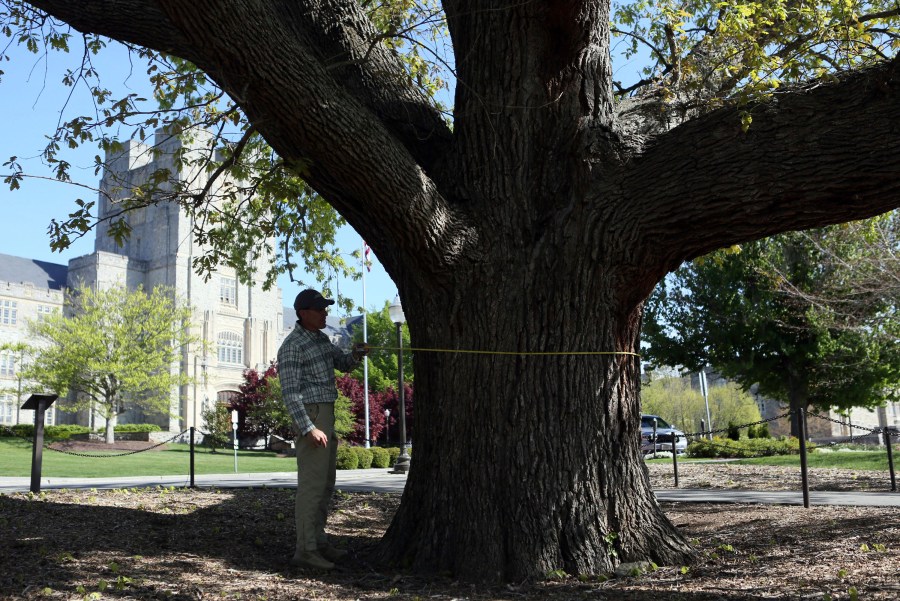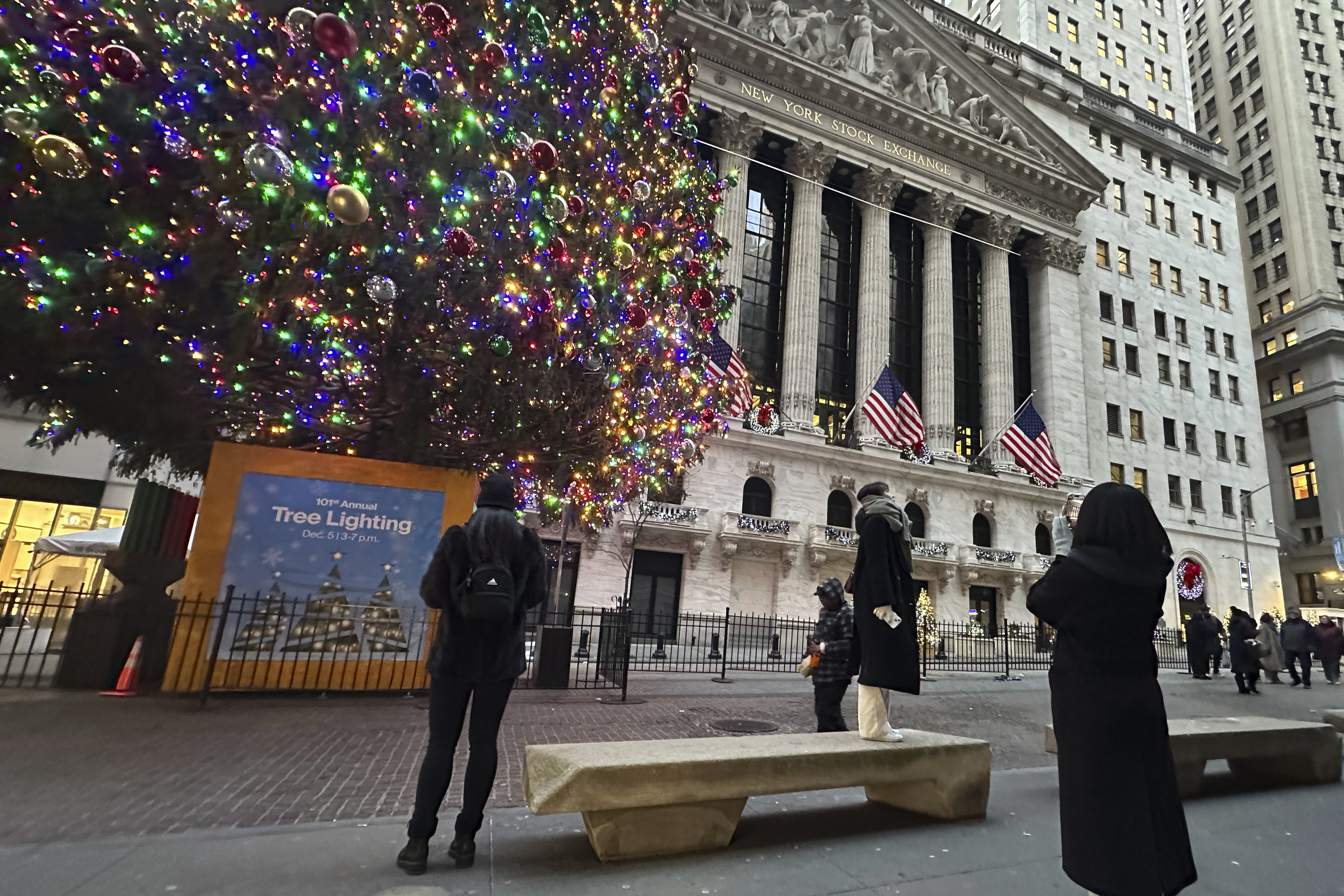ROANOKE, Va. (AP) — Students squinting along a sunny stretch of sidewalk outside the Roanoke College library find a moment of cool refuge beneath the leafy shade of an old, but steady-growing champion.
A Dutch elm tree outside Fintel Library is the largest of its species measured in Virginia, with a trunk that’s almost 21 feet around, stretching about 94 feet up toward the sun. Lofty branches spread 80 feet outward, casting friendly shade to passersby on a hot spring day.
Using a long tape measure to note the tree’s width and spread, plus a laser tool to gauge height, volunteer tree steward Harry Van Guilder scribbled those arboreal measurements on his clipboard on a recent Wednesday. During the six year span since he last measured this state champion for the Virginia Big Trees program, Van Guilder said its trunk width grew at a rate of about an inch per year.
“For a tree at this maturity, and as slow-growing as they are, it still amazes me,” he said. “It’s starting to decline a little now. You can see the top is broken out, which may have been storm related. But then there are some dead limbs out toward the tips, and that’s a sign of age decline, or disease.”
Roanoke College puts a lot of time, money and effort into taking care of its urban forest on campus, including properly big trees like the state champion Dutch elm, said Bill Martin, manager of landscaping.
“We did just do a big inventory. That included over 500 trees,” Martin said. “We’re going to start tagging 50 of those with QR codes, so that we’ll be able to do a tour, a walk through campus.”

People can use their cellphones to scan those newly installed codes and read more about the species, size and history of notable trees on campus, he said. First stop on the campus tour is that state champion Dutch elm shading High Street, which has outlived human memory, and whose planting might date back more than 180 years, to before 1842.
“I read somewhere that it was planted before or around when the school was started,” Martin said. “So that tree predates Roanoke College, and obviously survived surrounding construction and other things.”
The college hires out expert arborists to care for its trees, maintaining an urban forest of more than 1,000 trees from 77 different species, he said. In addition to surviving the elements, certain species, like the state champion Dutch elm, endure unique threats, such as fungal disease.
“Wind damage, storm damage. That tree does have lightning protection in it as well,” Martin said. “We treat several elm trees on campus for Dutch elm disease, and that’s one of them.”
It’s the only champion tree on Roanoke College campus, he said.
“We did lose a champion gum on Elizabeth Campus several years back to lightning,” Martin said.
At Virginia Tech, meanwhile, professor Eric Wiseman coordinates the Virginia Big Trees program, and maintains a list of state champions for more than 300 species.

“Many of these champion trees, they’re not out in the wilderness,” Wiseman said. “They’re in places that are right around the corner, and oftentimes these trees are located at places that have either cultural or historical significance.”
But champion trees do not often hold their title for long, he said. The big trees program makes an effort to remeasure state champions at least once every decade.
“Not all champion big trees are necessarily at the end of their biological lifespan, but a lot of them are, so something that often catches up with these trees is old age,” Wiseman said. “Another big one is storm damage, either lightning strikes or ice storms.”
Forests — full of big trees and small — fulfill other important purposes that people might not notice, he said.
“These trees, in my opinion, serve as ambassadors of our forests. People are enamored and curious about superlatives, the biggest of something,” Wiseman said. “If we can get people curious about superlative trees, we now have a gateway to talk to them about forest ecology, conservation and all the important roles trees play in day-to-day life.”
Trees provide ecosystem services like protecting water quality, and storing the carbon that people emit into the atmosphere when driving cars and using other devices that burn fossil fuels, he said. Bigger trees store more carbon.
Another valuable service is that refreshing shade offered by trees on a hot day.
Roanoke College Professor Katherine O’Neill has led environmental studies students in recent years to map urban heating in Salem, part of a statewide effort to chart temperature variations in cities across Virginia.
“What we found is a lot of cities will have elevated heat relative to the surrounding rural area. That’s because there’s less green space, less water movement, and a greater area of dark surfaces like asphalt and dark-colored roofs,” O’Neill said. “We found the neighborhoods that were most impacted by that, and those are some areas where we are currently planting food forests.”
As Juneberry and pecan and pawpaw trees planted recentl by Roanoke College students grow, their branches will shade surrounding neighborhoods, providing respite from the sun. And as an added bonus, the plants will seasonally grow edible produce.
“In addition to helping to offset the cooling, they’re also providing other ecosystem benefits,” O’Neill said. “They’re contributing to biodiversity, helping with stormwater runoff, and also maybe increasing some community resilience by providing another source of food.”
Whether any of the newly planted saplings in Salem sprout up into state champions for their species is a test for time, said Wiseman, the Virginia Big Trees coordinator.
“Many champion trees were planted by someone 100 or 150, maybe even 200 years ago,” Wiseman said. “That’s kind of inspiring to me, if someone goes out and plants a tree today, what they’re planting could eventually have the claim to fame of being the biggest of its kind in the state.”
Van Guilder, the volunteer tree steward, said his group, Trees Roanoke, is about 50 people strong and always seeking new members. To get involved, he said go online to treesroanoke.org.
“It’s tree huggers like me that are interested,” Van Guilder said, measuring the state champion Dutch elm. “It’d take several of us to hug this tree.”
On a slope of U.S. Forest Service land near the Blue Ridge Parkway in Botetourt County earlier this year, Dan Miles and Beck Stanley walked across the new Virginia champion pignut hickory tree, measuring more than 130 feet tall.
Stanley said big trees are just one of the amazing things you’ll find in Virginia’s mountain woodlands. He said:
“It shows that some of the greatest wonders in life are often right in our own backyard.”















































